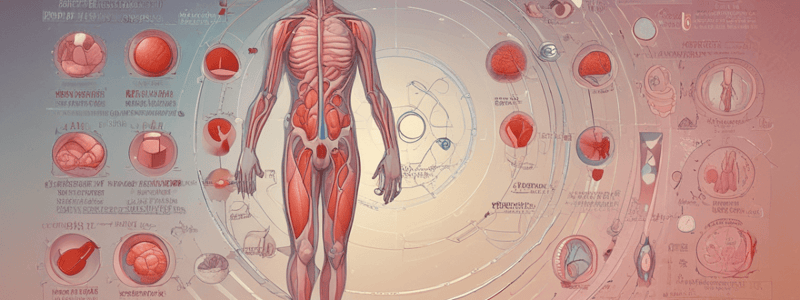Podcast
Questions and Answers
What is the approximate percentage of pancreatic islet cells that produce insulin?
What is the approximate percentage of pancreatic islet cells that produce insulin?
- 50%
- 20%
- 90%
- 70% (correct)
What is the function of acinar cells in the pancreas?
What is the function of acinar cells in the pancreas?
- To produce insulin and glucagon
- To produce somatostatin
- To produce an enzyme-rich juice for digestion (correct)
- To regulate blood sugar levels
What is the name of the hormone produced by alpha cells in the pancreatic islets?
What is the name of the hormone produced by alpha cells in the pancreatic islets?
- Glucagon (correct)
- Somatostatin
- Hormone X
- Insulin
What is the primary function of the pancreatic islets?
What is the primary function of the pancreatic islets?
What is the name of the hormone produced by beta cells in the pancreatic islets?
What is the name of the hormone produced by beta cells in the pancreatic islets?
What is the term for high blood sugar levels?
What is the term for high blood sugar levels?
What is the term for low blood sugar levels?
What is the term for low blood sugar levels?
What is the approximate percentage of pancreatic islet cells that produce glucagon?
What is the approximate percentage of pancreatic islet cells that produce glucagon?
Flashcards are hidden until you start studying
Study Notes
Diabetes Mellitus
- Diabetes is a condition that causes a person's blood sugar level to become too high, associated with dysfunction of the peptide hormone insulin.
- Identified in ancient Egypt (ca. 1500 B.C.) and in ancient India (~500 A.D.) as two separate conditions: one affecting children, leading to death in days, and another affecting the elderly and overweight, leading to death in years.
Pancreas
- The pancreas is a triangular gland behind the stomach.
- It is a mixed gland, consisting of both exocrine and endocrine tissue.
- The pancreas is composed of:
- Acinar cells (98%): produce enzyme-rich juice for digestion.
- Islets of Langerhans (2%): endocrine tissue responsible for producing hormones.
- Principal function of the pancreas: to secrete insulin and glucagon.
Glucose Metabolism Regulation
- Pancreatic islets (islets of Langerhans) contain specialized endocrine cells.
- The endocrine cells are responsible for producing:
- Alpha (α) cells: produce glucagon (a hyperglycaemic hormone), essential for controlling blood glucose levels (20%).
- Beta (β) cells: produce insulin (a hypoglycaemic hormone), antagonistic to glucagon (= 70%).
- Delta cells: produce somatostatin, which inhibits both glucagon and insulin secretion.
Studying That Suits You
Use AI to generate personalized quizzes and flashcards to suit your learning preferences.



